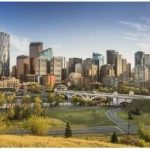Canada Overview
Canada is an increasingly important partner in education and research collaboration among developed countries. Topics of common interest here are above all energy, medical research, bio- and nanotechnology as well as environmental and Arctic research.
Population / geography
| Country name | Canada |
| Capital | Ottawa |
| Land area | 9,984,670 km ² |
| Population | 34,834,841 |
| Life expectancy | Men: 79.07 years,Women: 84.42 years |
| Age structure | 0-14 years: 15.5% 15-64 years: 67.2% 65 years and older: 17.3% |
| Population growth | 0.76% |
| Languages | English (official language) 58.7%French (official language) 22%
Punjabi 1.4% Italian 1.3% Spanish 1.3% German 1.3% Another 14% |
| Religions | Christianity 77%, of which 43.2% Roman Catholic, 29.2% Protestant (United Church of Canada, Anglican Church of Canada, Baptist, Lutheran & Presbyterian)Islam 2%,
Judaism 1.1%, Hinduism 1%, Buddhism 1%, Sikhism 0.9%, Other 16.2% (2011 estimate) |
| National day | July 1st (Canada Day) |
| Time zone | Pacific Standard Time: CET – 9 (UTC – 8)Mountain Standard Time: CET – 8 (UTC – 7)
Central Standard Time: CET – 7 (UTC – 6) Eastern Standard Time: CET – 6 (UTC – 5) Atlantic Standard Time: CET – 5 (UTC – 4) Newfoundland Standard Time: CET – 4:30 hours (UTC – 3:30) |
| Independence | 1867, fully sovereign since April 17, 1982 (Constitution Act) |
| Currency | 1 Canadian dollar CAD / 100 cents |
Sources: Countryaah.com
Politics / Administration
| Country name | Canada / Canada |
| Capital | Ottawa |
| Form of government | State constitutional monarchy |
| Head of state | HM Queen Elizabeth II in Right of Canada, represented by HE the Right Honorable Julie Payette, Governor General and Commander-in-Chief of Canada |
| Head of government | The Right Honorable Justin PJ Trudeau (Liberal Party), Prime Minister since November 04, 2015 |
| Foreign Minister | Marc Garneau |
| Minister for Innovation, Science and Industry | François-Philippe Champagne |
| Houses of Parliament | Parliament with two chambers (House of Commons: 338 seats; Senate: 105 seats); parliamentary system of government with majority voting (direct mandates) |
| Ruling parties | Liberal Party of Canada; Parti Libéral du Canada (CPC); Liberal Party of Canada (157 seats) |
| Opposition parties | Conservative Party: 121 seats;New Democratic Party (NDP) – Social Democratic: 24 seats;
Bloc Québecois (BQ) – separatist: 32 seats; Green: 3 seats |
| Administrative structure | Federal administrative structure with ten provinces and three territories |
Political system
Canada is a federal state (“Confederation”) with ten provinces and three federal territories. The country belongs to the British Commonwealth. The British monarch, Queen Elizabeth II, is also the head of state of Canada, and her representative is the governor general, who is appointed for five years. Anglophone and Francophone Canadians have been alternating between Anglophone and Francophone Canadians since the 1950s in this position, which is mainly given representative tasks. Since October 2, 2017, this office has been exercised by the engineer and former astronaut Julie Payette.
The federal government in the capital Ottawa, headed by the prime minister, who has extensive powers, is responsible for foreign policy, defense, trade, monetary affairs, transport and mail as well as overseeing the administration of the three federal territories Yukon, Northwest Territories and Nunavut.
The parliament consists of the lower house (” House of Commons “) with 338 members, who are elected for five years by majority vote, and the upper house (Senate). The 105 senators are not elected, but appointed by the Governor General on the proposal of the Prime Minister and according to constitutionally established regional quotas. Although the Senate sees itself as an expression of the federal system, it is not a representative of the provinces. The constitution does not provide for this. The prime ministers of the provinces usually meet once a year for the so-called ” First Ministers’ Conference “.
The provinces manage themselves largely independently, and their parliaments pass their own laws. The province is responsible for the areas of education, culture, police, health, social affairs and the economy, and in particular the use of natural resources. The province of Québec has a legal system that differs in many ways from the rest of Canada.
The Canadian Liberals have been ruling Ottawa since November 2015, led by Prime Minister Justin Trudeau. After the elections on October 21, 2019, Prime Minister Trudeau no longer has a majority, but was able to form a minority government with his Liberal Party with 157 seats. The social democratic New Democrats (NDP) with currently 24 seats achieved significant losses. The Conservative Party recorded gains with 121 seats and the Bloc Québécois with 32 seats.
Business information
Canada is one of the leading economies in the world. The country is rich in raw materials and an important agricultural producer. However, the focus of economic activity is increasingly shifting towards services and future technologies.






